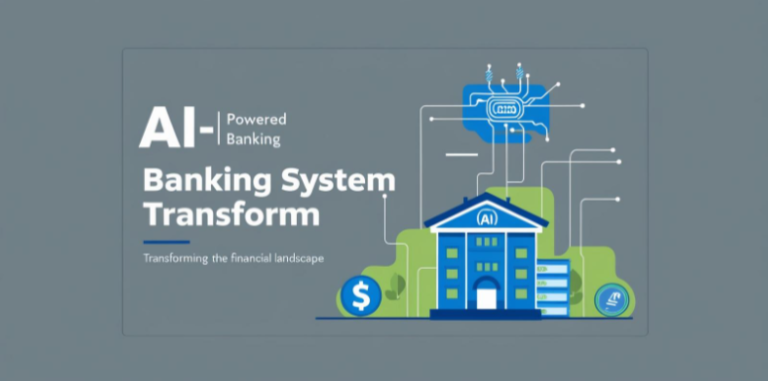
Along with the digital age, the banking sector is in for a gargantuan shift, led by the adoption of Artificial Intelligence (AI) . From customized financial advice to advanced fraud detection, AI-powered banking AI-powered banking systems are revolutionizing the operations and customer interaction of banks and other financial organizations. With increased customer expectations, rising cybersecurity threats, and the need for operational efficiency, AI is no luxury but a necessity for modern banking.
The Transformation of Banking via AI
The old banking was characterized by bricks-and-mortar branches, human interaction, and manual handling. Today's 21st-century customer wants service 24/7, online transactions in an instant, and customized experiences. AI, possessing the functions of learning, adapting, and automating, is stepping in where it fits effectively.
Banks have evolved from simple digital platforms to intelligent ecosystems utilizing machine learning, natural language processing (NLP) , robotic process automation (RPA), and big data analytics. These technologies combined improve customer care, identify anomalies, oversee risk, and generate revenue.
Key Applications of AI in Banking
1. Chatbots and Virtual Assistants
Chatbots enabled by artificial intelligence are perhaps the most prominent manifestation of AI in banking. They respond to customer queries in real-time, delivering information regarding account balances, eligibility for loans, transaction records, and much more—automatically.
Banks such as copyright (its virtual assistant Erica) and HSBC HSBC are investing heavily in virtual assistants offering 24/7 customer service. Virtual assistants are created with NLP and can understand and respond to human language, making customer service more accessible and efficient.
2. Fraud Detection and Prevention
AI systems can scan millions of transactions in seconds and detect fraud by identifying patterns and anomalies. Unlike conventional systems, AI learns from historical data and adapts to emerging fraudulent techniques.
Machine learning Machine learning monitors transactions and alerts users of suspicious activity—boosting both security and consumer trust.
3. Credit Score and Risk Assessment
AI enhances traditional credit scoring by analyzing additional data like internet activity, utility payments, and employment status. This is especially valuable for individuals with no or limited credit history.
AI helps banks minimize default risk and extend credit to a broader consumer base.
4. Banking and Financial Planning
AI provides personalized financial solutions based on consumer behavior. For instance, consistent savings behavior may prompt the system to suggest high-yield investment options.
Robo-advisors like Betterment and Wealthfront use AI to offer tailored investment advice at lower costs than traditional financial advisors.
5. Automated Back-Office Procedures
RPA automates repetitive tasks like data entry, compliance checks, and reporting. This reduces human error, speeds up processes, and frees employees for higher-level work.
AI also supports regulatory compliance by monitoring global legal changes and ensuring adherence with minimal human involvement.
Advantages of AI in Banking
- Enhanced Efficiency: AI eliminates manual intervention, simplifies processes, and accelerates banking operations.
- Lower Expenditure: Automation and fraud prevention reduce operational costs significantly.
- Improved Customer Experience: 24/7 support and personalized service enhance satisfaction and engagement.
- Data-Driven Decisions: AI analyzes large datasets to uncover patterns and predict market trends for better decision-making.
Challenges and Considerations
1. Data Security and Privacy
Handling financial data requires strict adherence to regulations like GDPR and CCPA. Poor data governance can lead to compliance violations and reputational damage.
2. Bias in AI Models
AI is only as good as the data it's trained on. Inaccurate or biased data can result in discriminatory outcomes, such as unfair credit scoring. Ongoing auditing and fairness testing are essential.
3. Adherence to Rules
AI systems in banking must comply with evolving legal frameworks ensuring transparency, explainability, and accountability (e.g., the EU AI Act).
4. Human-AI Collaboration
AI is meant to augment human capabilities—not replace them. Training employees to interpret and utilize AI insights is critical for success.
The Future Potential of AI in Banking
The future of AI in banking will be shaped by innovation innovation and cross-disciplinary tech. Key developments include:
- Voice Banking: Integration with smart assistants like Alexa and Google Assistant.
- Predictive Analytics: Anticipating customer needs before they arise.
- Open Banking + AI: Granting users more control over financial data and fostering innovation.
- Generative AI, Blockchain, and Quantum Computing: Emerging technologies that will redefine how banks operate and serve customers.
Conclusion
AI in banking is no longer a futuristic concept—it’s the present reality. Financial institutions leveraging AIgain advantages in customer experience, operational efficiency, and fraud prevention. However, ethical implementation is crucial to maintaining trust, fairness, and transparency.
As we transition to a more data-driven financial landscape,AI will remain at the forefront of banking innovation, enabling smarter, safer, and more inclusive services for everyone.